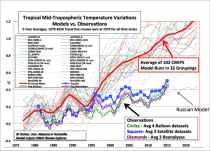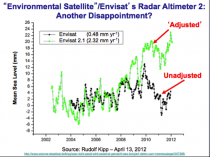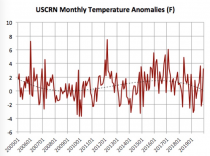SURFACE TEMPERATURE RECORDS: POLICY-DRIVEN DECEPTION?
This paper was a compilation of analyses relative to the data sets used for formulating and implementing unprecedented policy decisions seeking a radical transformation of our society and institutions. It was necessitated by the extraordinary revelations in the released CRU emails, including the admissions of Ian “Harry” Harris, the CRU programmer. He lamented about
“[The] hopeless state of their (CRU) database. No uniform data integrity, it’s just a catalogue of issues that continues to grow as they’re found” and “Aarrggghhh! There truly is no end in sight. This whole project is SUCH A MESS. No wonder I needed therapy!” CRU member, Phil Jones, candidly confessed in a BBC interview that “his surface temperature data are in such disarray they probably cannot be verified or replicated.”
This reflects on both NOAA and NASA in the United States. Phil Jones also admits that
“Almost all the data we have in the CRU archive is exactly the same as in the GHCN archive used by the NOAA National Climatic Data Center” and that NASA’s GISS uses the GHCN, applying its own adjustments, as it explains: “The current analysis uses surface air temperatures measurements from the following datasets: the unadjusted data of the Global Historical Climatology Network (Peterson and Vose, 1997 and 1998), United States Historical Climatology Network (USHCN) data, and SCAR (Scientific Committee on Antarctic Research) data from Antarctic stations.”
The paper is also a natural progression of the ongoing work of the authors, who have focused on actual data instead of models and theories. Anthony Watts put together a volunteer team to do the due diligence the government said it could not afford on the stations and found the vast majority (90%) to be sited poorly by the governments own standards. He has documented issues with the equipment and shelters and he and his Watts Up With That bloggers have documented many station issues created by post-processing of raw data.
Joe D’Aleo was inspired many years ago by association with the father of Climatology, Helmut Landsberg, to study the effects of urbanization and land use changes on microclimates. He has tracked research on data quality issues including station dropout, increasingly missing months and contamination by urbanization and land use changes. Joe has alerted NOAA and the EPA about poor integrity of the data bases.
Also as a contributing programmer/researcher, E.M. Smith has been working with the NOAA Global Historical Climate Network (GHCN) and NASA’s GIStemp program for processing the NOAA global data. Smith’s forensic background and skills allowed him to parse the data by country, latitude and elevation characteristics. Watts and Smith are intimately familiar with the poor metadata, which makes the critical analysis of the historical record and data
adjustments challenging or even impossible.
This paper inspired and motivated others toward a more in depth look into the data and methodology - a positive and welcome development long overdue. CRN was introduced but is now hard to find in useful forms. ARGO Buoys provided the important global ocean data coverage but the data set like other data sets like USHCN v1 that had an adjustment for UHI and new technological advances for getting at other data like UAH/RSS satellite derivations of lower tropospheric temperatures, measure from space of sea levels get ‘adjusted’ to better fit the modelling instead of motivating changes to the theory and GHG models which greatly overdo the natural cyclical warming.



One of the addendum studies related to the shocking differences for CPK temperatures from the different data sets like raw observations, USHCNv1 with UHI and USHCNv2 with homogenization replacing UHI and GHCN with no UHI.




